(W) I-L-L! I-N-I!
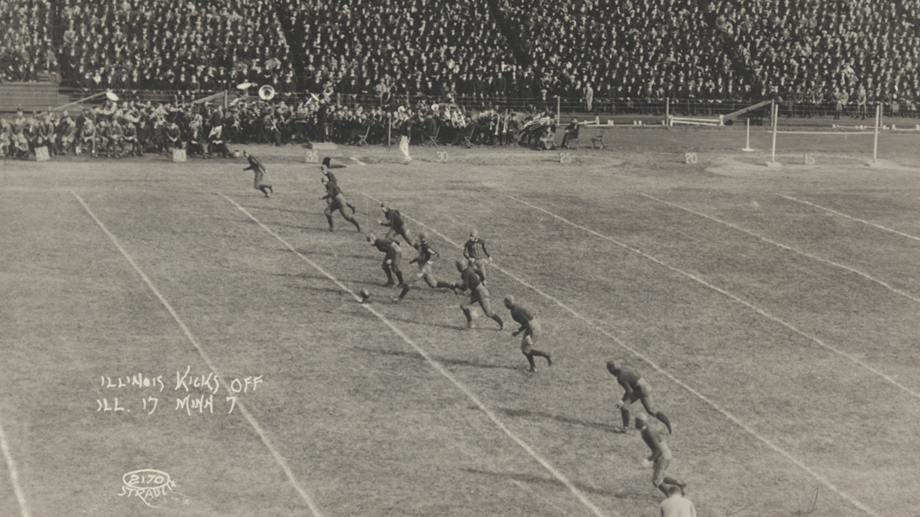
Illinois homecoming game against Minnesota, October 30, 1920. University of Illinois Archives
Today’s listeners might not immediately associate WILL with sports, but for a time, tuning to WILL was the only way to catch Illini football, basketball, and baseball games outside of the stands. In the early days of WILL, the broadcasting of Illini sports was a highly popular component of programming that helped to not only promote the university but also win support for the fledgling station.
Even before WILL first went on air, students from the electrical engineering department began broadcasting results of athletic contests under an experimental radio license in the fall of 1921. Technically, this was against federal regulations because it constituted “entertainment,” and an experimental license was only intended for technical training and the exchange of messages between fellow amateurs. The Federal Radio Commission caught wind of this in February 1922 and disallowed them from broadcasting the results. Professor H. A. Brown, who was in charge of the wireless outfit, explained, “Though we shall not be able to send out reports of games as we did during the football season for the benefit of hundreds of amateurs in the vicinity, the order will not prevent the exchange of messages between regular stations. We will still receive and send scores of basketball games to all the Big Ten stations.”
The university applied for an official broadcasting license the following month. When WILL (then “WRM”) came on the air for the first time on April 6, 1922, the 30-minute broadcast featured headlines from the Illini track and baseball teams. But WRM soon wanted to do more than just report the end results of athletic contests—it wanted to relay the action in real time.
Football was especially of interest to listeners in the early 1920s. Collegiate football was entering its golden age, the game surpassing baseball as America’s most popular athletic spectacle. Coliseum-like stadiums were popping up all across the country—University of Illinois’ Memorial Stadium among them—and a national professional football league had just been established in 1920. Interest in the game had reached new heights.
John E. Parks, an electrical engineering student from the class of 1923, described how WRM broadcast its first football game in a letter he wrote later in 1959: “One Saturday (fall of 1922, I think) we decided to broadcast the Illinois–Northwestern football game which was played on old Illinois Field. We ran a telephone line from the lab to the field and stationed a man at each end. The field man phoned the plays to the lab man and the latter repeated them into the mike to put it on the air. The lab man soon found that it was rather difficult to repeat a play into the mike while listening to the report of the following play coming over the telephone.”
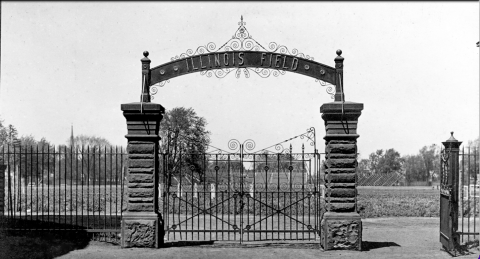
Entrance to Illinois Field c. 1913 from the University of Illinois Archives.
Built in 1891, Illinois Field was home to the football team until 1923, at which point they moved into Memorial Stadium. But Illinois Field was the hub of student life for nearly a century. As well as hosting the baseball team until 1986, the field was the site of military exercises, festivals, and other student traditions like the annual Freshman cap burning and the Class Scrap. Fortunately for the radio operators at WRM, the Electrical Engineering Laboratory was not too far from the field, which was located on the corner of University and Wright at the current site of the Beckman Institute and North Quad. For more on the history of Illinois Field, see here.
You can see from the map below where John Parks and his classmates had to run the telephone line. One only hopes Springfield Avenue was less busy in 1922 than it is today!
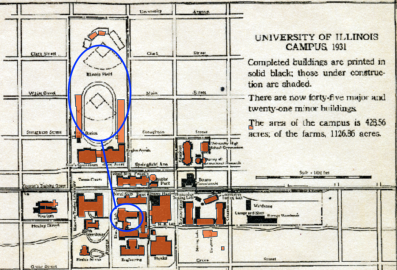
Map of campus from 1931, showing the location of the Electrical Engineering Laboratory (bottom) and Illinois Field (top).
The Illinois–Northwestern game of 1922 was a big event. It was the first time the two teams had played each other in seven years. Plus, it was Dad’s Weekend. With 3,500 dads, 1,500 Northwestern supporters, 275 band members, and thousands of Illini fans in attendance, the stands at Illinois Field were nearly at capacity (about 23,000). Though the Illini had a long track record of soundly beating Northwestern, four of the Illini’s star players were injured, and the Wildcats had had a strong season so far under their new coach Glenn Thistlethwaite. Fortunately, Illini football coaching legend Bob Zuppke and his “Zuppmen” eked out a narrow win. Down 3–0 in the second half, the Illini scored two field goals thanks to “the educated toe” of quarterback Steve Coutchie, for a final score of 6–3.
Thanks to the ingenuity of students like John Parks, WRM’s coverage of the Illini’s clash with the Wildcats was a success. But they wished to improve the efficiency of the operation. Broadcasting a true play-by-play account of the game with an announcer on-site would require the university to install cables underground to connect the newly finished Memorial Stadium with the lab. By the Illini’s contest with Wisconsin in 1923, the necessary cables had been laid, as recounted by the Daily Illini:
“The signal corps unit of the University brigade was necessarily called in to make the affair possible. Because there are no University telephone wires in the Stadium press stand, the signal corps stretched wires from the press box to the Armory where a connection was made with the regular University cables. From this point connection was made with the Electrical Engineering Laboratory where the broadcasting outfit is located. By this arrangement the reports were sent without a relay, the music of the bands, the cheering, and the announcement of plays all going forth over the country without interruption.” Letters streamed in from alumni across the country lauding WRM’s coverage of the game. Though the messages also praised WRM’s other content, including the musical selections and educational content, the announcing of the football game drew the most praise.
The Legacy of Red Grange
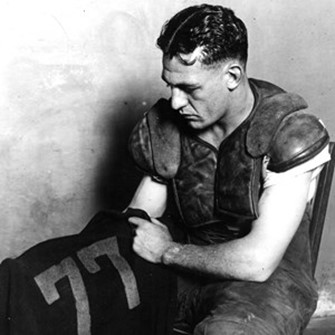
Red Grange and his famous jersey #77 after his last Illinois Game in 1925. University of Illinois Archives.
Interest in football continued to grow nationwide during the 1920s, due in no small part to arguably the first star of the game, Harold “Red” Grange. The three-time All-American halfback, who played for the Illini from 1923 to 1925, is still considered the greatest collegiate player of all time. He was known for his lightning speed and long runs, which earned him the nickname “The Galloping Ghost.”
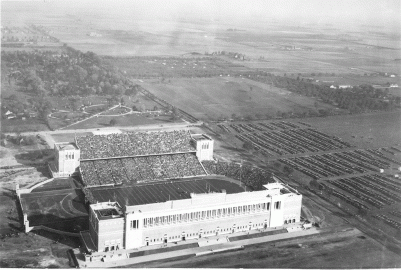
Aerial shot of the Memorial Stadium dedication game against Michigan on October 18, 1924. University of Illinois Archives.
He achieved his idol status during the Memorial Stadium dedication game against Michigan on October 18, 1924. Before 67,000 spectators, Grange scored four touchdowns in the first 12 minutes, covering an astonishing 262 yards. In the second half, he ran a fifth touchdown and threw for a sixth. After his final collegiate game in 1925, he dropped out of the University of Illinois to sign on with the Chicago Bears, drawing unprecedented crowds on their barnstorming tour of the US. His star power arguably saved the struggling national football league and propelled football into becoming America’s most popular sport.
WRM was perfectly situated to take advantage of the phenomenon that was Red Grange. Cultural historian Jerome Rodnitzky pointed out, “In the era of the raccoon coat, frenzied alumni, Greek fraternities, hip flasks, and the big Saturday game, football broadcasts produced synthetic alumni.” That is, people who otherwise had no connection to the university became loyal followers of the university’s sports teams via WRM, later to become WILL. Sports broadcasting thus promoted the University of Illinois on a broader level and endeared WILL to listeners far and wide. For the first few decades, thousands of alumni and fans came to associate Illini sports with the call letters “WILL,” without which they would have had no way to catch the games outside the stadium.
WILL’s sports coverage soon expanded to away games. In 1930, the university leased a special Western Union wire that went from Ferry field at the University of Michigan to WILL. Jim McEdwards, Dailly Illini sports editor, and Vladas Jurgelonis, associate sports editor, gave the details of the game over the wire from Ann Arbor, while in the studio, WILL announcer Paul Beam transformed the play-by-play account into a gripping story of an underdog team determined to beat the titled Wolverines. Letters and telegraphs streamed in from listeners expressing their gratitude for the realistic manner in which WILL presented the game: “Special effects, to aid the listeners in imagining a cheering crowd and Michigan’s band, were brought to the radio audience through phonograph records played at the WILL studio at appropriate moments.”
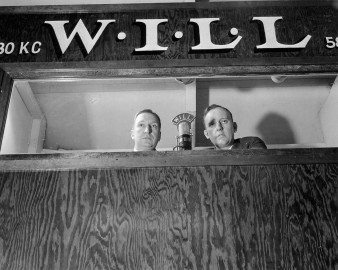
Veteran WILL sports announcers Fred Corray (left) and Jim Ebel broadcast from Huff Gym in 1944.
Given the difficult logistics of leasing such wires, the university did not do this for every away game. But by the late 1930s, as technology improved, WILL was able to broadcast all Illini basketball games, both home and away. Former WILL engineer Jim Ebel recounted how they accomplished this: “I carried the remote equipment with me when I traveled with the team. I made the set up in the coliseums and obtained a spotter from the team we were playing, and handled the broadcast myself. I was a one-man broadcast team to save expense for the university.” Thanks to the ingenuity and adaptability of WILL staff, the station was able to continue to connect listeners to the university through its sports broadcasts no matter the location.

